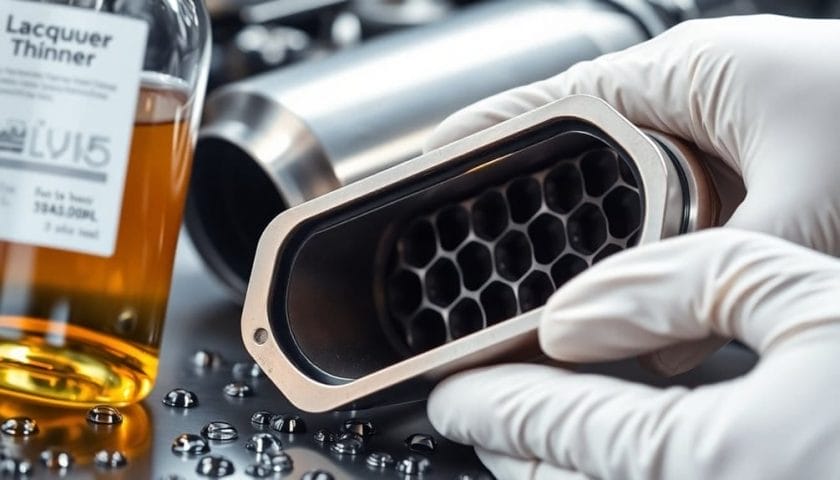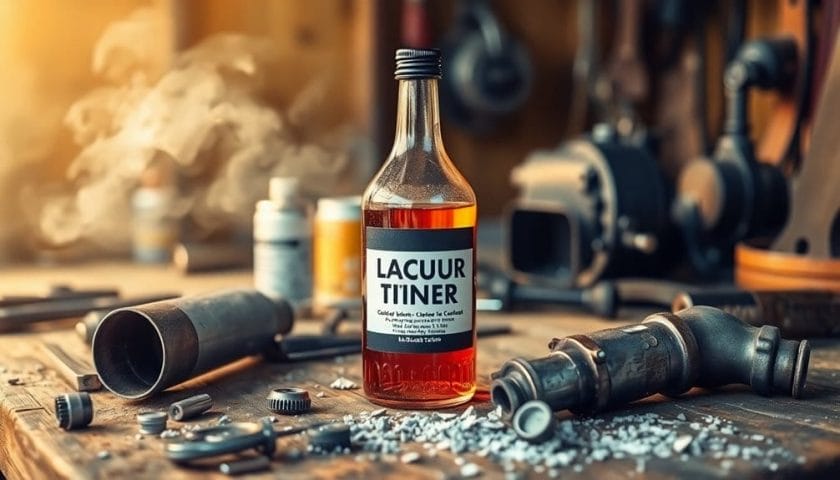I've found that using lacquer thinner can be effective for cleaning catalytic converters due to its solvent properties, which dissolve carbon deposits and contaminants. However, it's vital to exercise caution, as lacquer thinner is highly volatile and can pose health risks, including respiratory issues if inhaled. Proper ventilation and protective gear are essential when using it. While this method can provide temporary relief for minor clogs, it may not resolve deeper issues with the converter. Exploring alternative cleaning methods and understanding maintenance best practices can further enhance the longevity and performance of your vehicle's exhaust system.
Key Takeaways
- Lacquer thinner can dissolve stubborn deposits in catalytic converters due to its blend of potent solvents.
- Use lacquer thinner in well-ventilated areas and with appropriate safety gear to minimize health risks.
- DIY cleaning with lacquer thinner may only provide temporary relief and could damage the catalytic converter if not used cautiously.
- Eco-friendly alternatives like vinegar and baking soda may effectively clean without harsh chemicals or risks associated with lacquer thinner.
- For persistent issues, seeking professional cleaning services is recommended to avoid deeper problems and ensure optimal vehicle performance.
Understanding Catalytic Converters

Why are catalytic converters essential for modern vehicles? I've often wondered about their importance, and it's clear they play a fundamental role in emissions control. The catalytic converter function is to reduce harmful exhaust emissions produced by internal combustion engines. When fuel burns, it generates pollutants like carbon monoxide, hydrocarbons, and nitrogen oxides. The catalytic converter transforms these harmful substances into less harmful emissions before they exit the exhaust system.
Inside the converter, a catalyst—typically made from platinum, palladium, and rhodium—facilitates chemical reactions. These reactions convert carbon monoxide into carbon dioxide, reduce nitrogen oxides to nitrogen, and oxidize unburned hydrocarbons into carbon dioxide and water. This process is essential for meeting stringent environmental regulations and ensuring cleaner air.
Without a properly functioning catalytic converter, vehicles would emit considerably higher levels of pollutants, contributing to air quality issues and health risks. Additionally, malfunctioning converters can lead to decreased engine performance and increased fuel consumption. Hence, understanding the catalytic converter function is imperative for any vehicle owner who wants to maintain their vehicle's efficiency and comply with emissions standards.
What Is Lacquer Thinner?
Lacquer thinner is a powerful solvent commonly used in the automotive and woodworking industries for thinning lacquer-based paints and cleaning tools. Its effectiveness derives from its unique lacquer composition, which allows it to break down and dissolve various finishes and residues. When I use lacquer thinner, I appreciate its solvent properties, which contribute to its versatility in different applications.
Here are some key aspects of lacquer thinner:
- Composition: It typically contains a blend of solvents, such as toluene, acetone, and methanol, which work together to enhance its cleaning abilities.
- Evaporation Rate: Lacquer thinner evaporates quickly, which minimizes the risk of runs and drips when applying lacquer paints.
- Cleaning Power: It's excellent for removing dried paint, grease, and other contaminants from surfaces and tools.
These features make lacquer thinner an essential product for anyone working with lacquer finishes. However, it's vital to use it in a well-ventilated area and with appropriate safety gear, as its fumes can be harmful. Understanding its composition and solvent properties helps me appreciate its role in achieving a professional finish.
How Lacquer Thinner Works

Understanding the composition of lacquer thinner lays the groundwork for grasping how it functions effectively as a cleaning agent. Lacquer thinner is a blend of various solvents, including toluene, acetone, and methanol, each contributing unique chemical properties that enhance its solvent effectiveness. These solvents have low molecular weights, allowing them to penetrate and dissolve a wide range of substances, including oils, resins, and carbon deposits.
When I apply lacquer thinner to a catalytic converter, its powerful solvent properties break down the stubborn residues that accumulate over time. The polar and non-polar components of lacquer thinner work synergistically; the polar solvents target water-soluble contaminants, while the non-polar solvents effectively dissolve hydrocarbons. This dual-action approach guarantees that even the most tenacious deposits are emulsified and lifted away.
Furthermore, lacquer thinner evaporates quickly, minimizing the risk of residue left behind post-cleaning. This rapid evaporation also helps guarantee that the catalytic converter doesn't remain saturated with solvent for extended periods, which could interfere with its function. Overall, understanding these chemical properties highlights the effectiveness of lacquer thinner as a cleaning agent for automotive applications.
Risks of Using Lacquer Thinner
Using lacquer thinner can pose several risks that shouldn't be overlooked. While it might seem like an effective solution for cleaning, the potential downsides are significant. First, I want to emphasize that lacquer thinner is highly volatile, which can lead to dangerous chemical reactions when mixed with other substances. These reactions could create harmful fumes or even explosive situations.
Moreover, using lacquer thinner raises serious environmental concerns. The chemicals in lacquer thinner can contaminate soil and water sources if not disposed of properly, impacting ecosystems and human health.
Here are three key risks to evaluate:
- Health Hazards: Inhalation or skin contact can lead to respiratory issues, skin irritation, or long-term health complications.
- Fire Risk: Its flammable nature means that improper handling can result in fire hazards, especially in confined spaces.
- Regulatory Issues: Many jurisdictions have strict regulations regarding the use of such chemicals, and non-compliance can lead to fines or legal repercussions.
Alternative Cleaning Methods

When it comes to cleaning, there are several effective alternatives to lacquer thinner that can minimize health and environmental risks. One of the best eco-friendly solutions I've found is using vinegar and baking soda. This combination creates a powerful reaction that can help break down carbon deposits, making it an effective DIY alternative for cleaning catalytic converters.
Another option is a commercial catalytic converter cleaner, which is specifically formulated to remove contaminants without harsh chemicals. These products often use biodegradable ingredients, making them safer for both the user and the environment.
If I'm looking for a more natural approach, I sometimes use lemon juice. Its acidity can assist in breaking down stubborn residues while leaving a pleasant scent.
Additionally, high-pressure water jets can be a practical solution for cleaning without any chemicals at all. This method is particularly useful for those who are concerned about chemical exposure.
Step-by-Step Cleaning Process
A thorough step-by-step cleaning process guarantees effective use of lacquer thinner while minimizing risks. When I clean my catalytic converter, I make certain to follow these precise steps to achieve the best results.
- Gather your cleaning supplies: You'll need lacquer thinner, a spray bottle, a soft brush, and safety gear, including gloves and goggles.
- Remove the catalytic converter: Safely disconnect it from the exhaust system, making sure that you have a clear workspace.
- Apply lacquer thinner: Fill the spray bottle with lacquer thinner and generously apply it to the interior surfaces of the catalytic converter. Let it sit for about 15-20 minutes to break down carbon deposits.
After the soaking period, I use the soft brush to gently scrub the interior, dislodging any remaining debris. Rinse thoroughly with water, and let the converter dry completely before reinstallation.
Preventative Maintenance Tips

Maintaining the performance of your catalytic converter is essential for vehicle efficiency and emissions control. To keep your system running at peak performance, I recommend following some preventative maintenance tips that can greatly impact your fuel efficiency and reduce harmful emissions.
Here's a quick reference table to guide you:
| Tip | Description |
|---|---|
| Regular Inspections | Check for any signs of wear or damage. |
| Quality Fuel | Use high-quality fuel to prevent deposits. |
| Engine Tune-Ups | Keep your engine well-tuned for peak performance. |
| Monitor Warning Lights | Address any dashboard alerts promptly. |
| Timely Oil Changes | Regular oil changes help reduce engine strain. |
When to Seek Professional Help
Seeking professional help can be vital, especially when you notice persistent issues with your vehicle's performance or emissions control. If your catalytic converter is not functioning properly, it can lead to significant problems, including reduced fuel efficiency and increased emissions. It's important to recognize the signs that indicate it's time to consult a professional.
Here are a few indicators suggesting you might need professional cleaning services:
- Your check engine light is on, and diagnostic tests point to catalytic converter issues.
- You experience a noticeable drop in engine performance, such as stalling or sluggish acceleration.
- There's an unusual odor coming from your exhaust, indicating potential blockages or malfunctions.
Ignoring these symptoms can exacerbate the problem, leading to costly repairs. While DIY cleaning methods, like using lacquer thinner, can be effective for minor clogs, they may not address deeper issues. A professional can provide a thorough assessment and offer cleaning services tailored to your specific situation. Remember, investing in professional help can save you time and money in the long run, ensuring your vehicle runs smoothly and efficiently.
Frequently Asked Questions
Can Lacquer Thinner Damage My Catalytic Converter?
I've found that using lacquer thinner can indeed harm your catalytic converter's longevity. Instead, I recommend exploring safer alternatives like specialized cleaners designed specifically for catalytic converters to guarantee peak performance without risking damage.
How Often Should I Clean My Catalytic Converter?
It's funny how often I overlook catalytic converter maintenance. I clean mine every 30,000 miles or as needed, depending on performance issues. Regular cleaning can prevent costly repairs and guarantee peak efficiency.
Is Lacquer Thinner Safe for All Car Types?
I've found that lacquer thinner isn't universally safe for all car types. For car maintenance, always prioritize chemical safety; some vehicles may react negatively. It's best to consult your owner's manual or a professional.
What Symptoms Indicate a Clogged Catalytic Converter?
When I notice poor acceleration and a rotten egg smell, it's clear there are clogged symptoms. These catalytic issues can lead to engine overheating and decreased fuel efficiency, signaling it's time for a thorough inspection.
Can I Use Lacquer Thinner in My Fuel Tank?
I wouldn't recommend adding lacquer thinner to your fuel tank. Its chemical reactions can damage your fuel system, leading to costly repairs. It's best to use products specifically designed for fuel treatment and maintenance instead.
